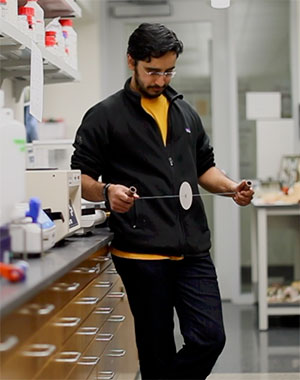Extreme Constraints and Curiosity Lead to True Innovation

Growing up in India, Saad Bhamla, like many children, routinely played with a traditional spinning whirligig — a simple toy that consists of a disc that rotates rapidly when twine threaded through the center is pulled apart by both hands. Three decades later, that fond memory sparked the idea for a 20-cent paper centrifuge that isolates blood-borne diseases like malaria and HIV.
How did Bhamla and the Manu Prakash bioengineering lab at Stanford University unearth a breakthrough medical innovation for the developing world from a children’s toy?
The epiphany for the so-called “paperfuge” did not come overnight. Bhamla and Prakash, a 2016 MacArthur Fellow known for building low-cost tools for health workers in the field, had brainstormed for weeks.
The requirements were stark. What would it take to design a centrifuge for under a dollar, that had the centrifugal force to separate blood into different components, and required no electricity?
Prakash had seen first-hand how medical inventions are implemented, or not, in the developing world. Visiting a clinic in Uganda, Prakash saw dormant centrifuges that cost hospitals $1,000 to $5,000. The clinic had no electricity and the centrifuge became a doorstop.
Prakash and Bhamla began by viewing the challenge as a physics exercise with clear and rigid parameters from which they could explore. Could they look at the everyday from a different perspective: the eyeglasses you wear or a beloved toy from childhood.
“What is the most efficient way to convert human energy into rotational energy,” Bhamla asked himself. “I actually just started on the back of an envelope.” He soon began looking up gears, examining egg beaters and salad spinners.
There’s a wonderment and optimism in the way Saad talks through his process. He looks to the pen in his hand and the flow of ink due to gravity. He questions and explains in equal parts — a tightrope walk that leans towards “what if,” then back towards the world of established physics.
A visiting scholar who performed as a circus artist in a former life made Bhamla think of trying a yo-yo. High-speed imaging revealed that it spins at about 3,000 RPMs when unfurled, which is about the same as smaller microfuges commonly found in labs. The problem was the learning curve: Bhamla was new to yo-yos, and it took too long to get the hang of it.
“That experience was valuable,” Bhamla said. “If I cannot learn it within a week, how am I going to train a 50-year-old health worker who has 200 patients standing outside with mothers and crying babies?”
They went through a drawer full of toys, scoured Amazon for ideas, and yet, nothing.
“You know when you’re tired and desperate, and you’re having one of those nights when you’re frustrated?” Bhamla explained. “You’re willing to explore anything and everything.” Then, the childhood memory of that whirligig popped into Bhamla’s head. He turned to his girlfriend and asked for a button and some string from her sewing kit and quickly fashioned a makeshift toy.
Back in the Prakash Lab, a high-speed camera showed the button whirligig could reach 15,000 rpms. “I couldn’t believe my eyes,” he recalled.
After two weeks of prototyping, he mounted a capillary of blood on a paper-disc whirligig and was able to centrifuge blood into layers. With proof-of-concept in hand, Bhamla and Prakash proceeded to scientifically explain how a whirligig actually works.

Bhamla recruited three undergraduate engineering students from MIT and Stanford to build a mathematical model. The team created a computer simulation to capture design variables like disc size, string elasticity and pulling force. They also borrowed equations from the physics of supercoiling DNA strands to understand how hand-forces move from the coiling strings to power the spinning disc.
Once the engineers validated their models against real-world prototype performance, they were able to create a version with rotational speeds of up to 125,000 rpm, a magnitude significantly higher than their first prototypes.
And unlike the case of the yo-yo, this so-called “paperfuge” could easily be mastered — and even built with everyday materials — by a villager in Africa.
From Bhamla’s perspective, better to put a simple device in the hands of a field worker who, without any knowledge of physics or education beyond grade school, sees centrifugal force come from what is essentially child’s play — and then thinks, “Hey, this is just twine, paper and wood. I can make one of these! What else can this be used for?”
Bhamla and Prakash’s paperfuge is a powerful example of how extreme constraints and intense curiosity can create innovation from the everyday. Today, community-health collaborators in Madagascar are working with the Prakash Lab to test the paperfuge in the field.
Seeing it in use, the new waves of curiosity it stirs and the potential for future innovations it may inspire, fulfill Bhamla more than anything else.
“That’s empowerment, when a person forgets that they’re not an engineer, but they can see problems and everything around them starts to look like a potential solution,” Bhamla said. “If you can tap into someone’s curiosity, I think you can change somebody’s life.”
Additional information:
Saad Bhamla is a postdoctoral fellow at Stanford University, where he earned a Ph.D. in chemical engineering in 2015. As part of his doctoral studies, he built a device to examine the non-Neutonian flow of liquids (think of the colorful swirls on the surface of a soap bubble). Learning about entrepreneurship through the Accel Innovation Scholars program at the Stanford Technology Ventures Program, Bhamla patented the device and sold it to two companies for contact lens design research. Learn More
The Prakash Lab is “a curiosity driven” research group working in the field of engineering and physical biology. One of the lab’s specialties is in an area pioneered by Manu Prakash known as “frugal science,” where he and his team design science-education and diagnostic tools for extremely resource constrained settings, especially in the field of global health. Learn More



